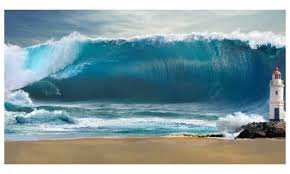Published: 30th July 2025 | The English Chronicle Desk | The English Chronicle Online
A powerful undersea earthquake measuring 8.7 on the Richter scale has triggered widespread tsunami warnings and mass evacuations across multiple countries bordering the Pacific Ocean. The quake, one of the most violent to hit the planet in over a decade, struck off the eastern coast of Russia’s Kamchatka Peninsula early Wednesday morning, sending seismic shockwaves rippling across continents and forcing millions to flee their homes from Japan to the United States.
The epicentre of the earthquake was located approximately 126 kilometers from the Russian city of Petropavlovsk-Kamchatsky, at a depth of 18 kilometers, according to data provided by the United States Geological Survey (USGS). The tremor has already caused considerable disruption in Russia’s Kuril Islands, where tsunami flooding reportedly damaged port infrastructure at Severo-Kurilsk. Authorities have confirmed that tsunami waves have made landfall on Japan’s northern island of Hokkaido and are advancing toward the U.S. west coast and the Pacific island state of Hawaii.
In Hawaii, a wave measuring more than six feet has already been detected off the coast of Maui, prompting an immediate halt to inbound flights. Panic and confusion gripped Honolulu, where long queues formed at petrol stations and roads became choked with vehicles heading for higher ground. Hawaiian Airlines and Alaskan Airlines suspended all operations to and from the state, citing concerns for passenger and crew safety.
Governor Josh Green of Hawaii addressed the public in an emergency press conference, stating that the state had so far avoided a “wave of consequence,” though he warned it was premature to declare the threat over. “Until we see what happens at the Big Island, we can’t say we’re in the clear,” Green said. He urged residents to remain indoors, avoid coastal areas, and follow live alerts. Black Hawk helicopters and high-water vehicles have been placed on standby to assist in rescue operations should conditions worsen.
In Japan, authorities ordered nearly two million residents across 21 prefectures to evacuate, with the worst-hit areas being Hokkaido, Kanagawa, and Wakayama. Footage aired on local networks showed families taking shelter on rooftops and high ground as tsunami sirens wailed across coastal communities. While no casualties have been officially reported, damage to transportation infrastructure has caused significant delays and disruption.
The tsunami threat has reverberated across the Pacific, prompting Chile, Peru, Ecuador, Mexico, and several Central American countries to issue alerts. Ecuador’s Oceanographic Institute warned that waves up to 1.4 meters could strike the Galapagos Islands — a fragile ecosystem home to unique species of wildlife. Mexico’s national tsunami alert system extended warnings from Ensenada to Panama, underlining the scope and unpredictability of the evolving emergency.
In the United States, the National Tsunami Warning Center has projected that if the waves retain momentum, they could reach California’s Fort Bragg by 11:50 pm, Monterey at 12:15 am, San Francisco at 12:40 am, Los Angeles harbor at 1:05 am, and the southern cities of Newport Beach, Oceanside, and La Jolla by 1:15 am. Authorities in affected states have activated emergency response protocols and urged residents to seek refuge away from shorelines.
Meanwhile, in Hawaii, tourists and locals alike described scenes of mounting anxiety. One honeymooning couple recounted their alarm when restaurant staff in Maui abruptly fled mid-shift to seek higher ground. “If they’re panicking, we must panic as well,” said Castro, a social media influencer from the mainland U.S., whose video clips of the incident have since gone viral.
The Pacific Tsunami Warning Center has called for urgent action to protect life and property, describing the event as a major seismic incident with the potential for “extensive coastal inundation and loss of life” if safety measures are not strictly followed. Although initial reports suggest that some areas like Hawaii may have been spared the worst, the situation remains fluid and unpredictable, with aftershocks and delayed wave formations still possible.
As the Pacific Rim holds its breath, emergency teams across the region remain on high alert. The international community watches with concern, reminded once more of the sheer power and reach of tectonic fury beneath the sea — and the unyielding vulnerability of millions who live in its path.






























